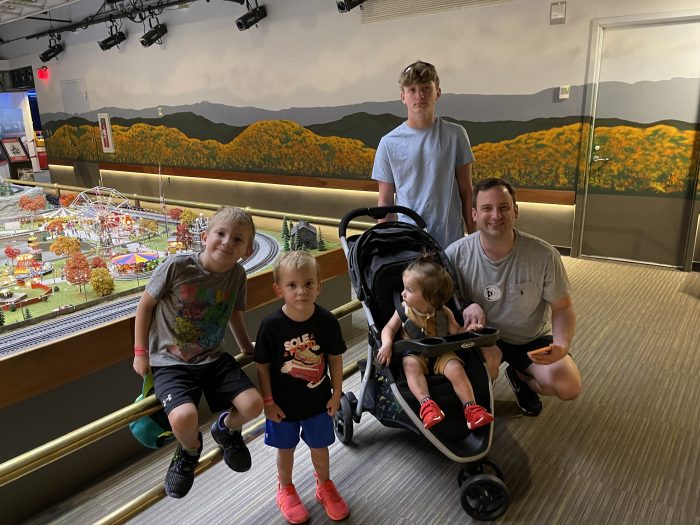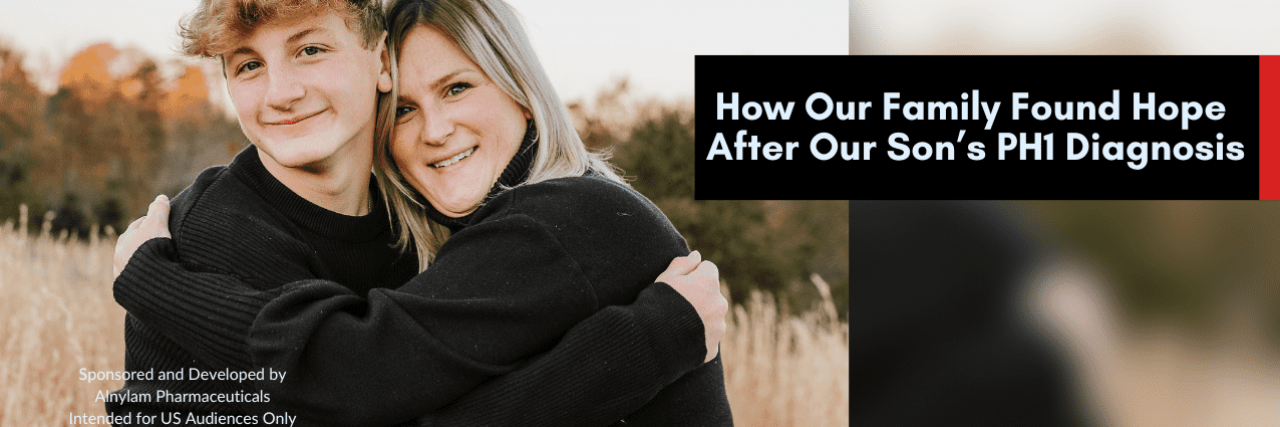How Our Family Found Hope After Our Son’s PH1 Diagnosis
Disclaimer: This article depicts Amy and her son Owen’s personal experiences with PH1 and OXLUMO® (lumasiran). Individual patient experiences will vary. Owen participated in the creation of this article, providing background information and giving permission to his mother to speak about his experiences.
For US audiences only.
To others, describing their child’s rare disease diagnosis as “bittersweet” might be hard to imagine, but after years of searching for answers, that is how it felt for my family and me. While the diagnosis paved a path forward in our son’s journey, the unknown left us lacking reassurance. In fact, his diagnosis was just the beginning of another long journey ahead.
When our son Owen was born, he began showing signs of primary hyperoxaluria type 1 (PH1) — a rare, inherited disease that can lead to kidney damage — including increased oxalate levels in his urine and blood, nephrocalcinosis (or increased calcium levels in the kidneys), urinary tract infections and recurrent kidney stones. However, because doctors were not looking at his symptoms holistically and identified his symptoms one-by-one throughout his infancy, we had difficulty putting the pieces together to determine the root cause.
It would be impossible to recall the number of providers we saw over the five years that we were searching for a diagnosis. However, I recall vividly meeting with a nephrologist who was able to connect the dots and suspected PH1.
In PH1, there is a build-up of oxalate due to an enzyme defect in the liver. Oxalate is a waste product that can’t be used by the body and is usually filtered by the kidneys. In people with PH1, the overproduced oxalate can combine with calcium, causing kidney stones and progressive damage to the kidneys. PH1 can be diagnosed by first measuring oxalate levels in the urine or blood, and then with a genetic test.
When people learned that we received a PH1 diagnosis for Owen, they expected us to feel relief — but that wasn’t the case. For me, the diagnosis was underwhelming and confusing. To help us navigate it, our nephrologist provided our family with as much information and as many resources as he could, but Owen was diagnosed with PH1 in 2013, and at that time, there wasn’t nearly as much information available as there is today.
Even with support and resources, our lives felt chaotic and challenging because of the unanswered questions about the disease, what to expect as a family, and even more so about Owen’s future and quality of life. The unknowns were incredibly difficult to navigate. Although, at the time we didn’t know how much research, resources and treatment would evolve in the coming years.
As caregivers of a child with PH1 may know, the disease can progress rapidly without a management plan. In the span of a year, Owen went from passing a kidney stone monthly to weekly to daily. Our nephrologist recommended hyperhydration — or drinking copious amounts of water each day — as one of the ways to manage Owen’s disease and help reduce the number of kidney stones he was producing. However, regardless of how much water Owen would drink each day, it felt like it was never enough.
We were really struggling with the symptoms of his condition. Daily life was exhausting and intimidating and we were left trying to manage his relentless, recurrent kidney stones as well as the pain and fatigue that accompanied them. Still, despite our best efforts, most days we couldn’t provide Owen with any symptom relief.
As he grew, Owen’s PH1 continued to progress rapidly and his life was impacted in several ways, including academically and socially. He missed a lot of school and could not hang out with his friends or participate in sports he enjoyed like football or soccer. Watching him miss out on such important childhood experiences made my heart ache.
Because of PH1, even today, when Owen wants to do something, like football or soccer, we have to weigh the pros and cons as a family and find opportunities to support his interests whenever we can. For example, though we can’t cheer Owen on from the football sidelines at school, we can give him opportunities to play safely in our backyard with his Dad and brothers.
Owen’s experience with PH1 has also allowed him to explore other hobbies he has come to enjoy, like music and jewelry-making. Owen is currently in the marching band at his high school (he plays the flute and has also played clarinet and alto saxophone!).

We were eventually introduced to lumasiran, which he was able to receive prior to U.S. Food and Drug Administration (FDA) approval through a compassionate use program. In November 2020, lumasiran was approved by the FDA as
OXLUMO® (lumasiran). Currently, OXLUMO is approved for the treatment of PH1 to lower oxalate in urine and blood in children and adults.
Since OXLUMO was still being evaluated in clinical trials at the time it was introduced to us, I had a lot of questions that we discussed with our health care team. We started by talking to our nephrologist about the possible risks associated with OXLUMO, such as injection site reactions. These discussions helped us decide to move forward with OXLUMO treatment.
After Owen began his treatment with OXLUMO, we noticed a reduction in the amount of oxalate in his urine. Today, Owen continues to receive his injections of OXLUMO from his doctor. Owen can still enjoy his hobbies; nevertheless, PH1 still impacts him, and he has learned to be cautious and listen to his body — we continue to encourage him to hyper-hydrate (Owen says that most of the time water solves everything!) and he follows a low-oxalate diet.

When following his treatment plan, Owen sometimes forgets that he has this condition, which is something we could only dream of when he was first diagnosed.
Although it has been challenging, Owen’s experience with PH1 has taught him to be compassionate and understanding, as people can’t always see when you’re in pain, and you don’t know what someone else might be going through. Owen has also joined a support group for other kids with health conditions at school and is able to have open discussions with his friends about his experience with PH1.
As a parent of a child with PH1, I want other parents to know that if your child is potentially experiencing symptoms of PH1, you should speak with your doctor about getting tested for PH1. If your child is awaiting a PH1 diagnosis or has already received one, I want you to know that there is hope.
We have access to so much more PH1 research and resources today, and although I still think there’s a need for greater awareness of PH1 and its symptoms, I am grateful that Owen has a management plan in place.
To learn more about OXLUMO, visit www.OXLUMO.com.
What is OXLUMO® (lumasiran)?
OXLUMO is a prescription medicine for the treatment of primary hyperoxaluria type 1 (PH1) to lower oxalate in urine and blood in children and adults.
IMPORTANT SAFETY INFORMATION
The most common side effect of OXLUMO is injection site reaction (redness, swelling, pain, bruising, itching, and discoloration at the site of injection). These are not all the possible side effects of OXLUMO. Talk to your doctor about side effects that you experience. You are encouraged to report negative side effects of prescription drugs to the FDA. Visit www.fda.gov/medwatch, or call 1-800-FDA-1088.
OXLUMO has not been studied in pregnant or breastfeeding women. Talk to your doctor about the risk of taking OXLUMO if you are pregnant, plan to become pregnant, are breastfeeding, or plan to breastfeed.
For additional information about OXLUMO, please see the full Prescribing Information.


